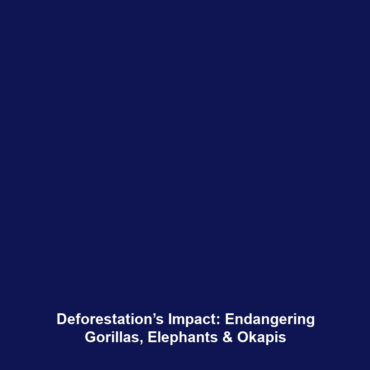How Deforestation for Agriculture, Logging, and Mining Threatens Species like Gorillas, Forest Elephants, and Okapis
Introduction
Deforestation for agriculture, logging, and mining is a pressing global issue that poses significant threats to biodiversity. This practice not only disrupts ecosystems but also endangers various species, including gorillas, forest elephants, and okapis. With forests being clear-cut for crops, timber, and minerals, we are witnessing unprecedented loss of habitat. Understanding the connection between these activities and biodiversity loss is crucial for conservation efforts and sustainable development. This article delves into how deforestation affects these species and highlights the urgent need for action to prevent further biodiversity decline.
Key Concepts
Deforestation and Its Drivers
Deforestation refers to the significant reduction of forested areas through various activities. The primary drivers include:
- Agriculture: Expansion of agricultural land leads to habitat destruction.
- Logging: Both legal and illegal logging contribute to forest depletion.
- Mining: Extractive industries clear large areas for mineral exploration, further fragmenting habitats.
Impact on Species
The activities leading to deforestation have dire consequences for several iconic species:
- Gorillas: Habitat loss reduces their living space and food sources, pushing them towards extinction.
- Forest Elephants: These elephants rely on dense forests for navigation and nourishment; their populations are declining due to logging.
- Okapis: As habitats become fragmented, okapis struggle to find mates and food, leading to reduced genetic diversity.
Applications and Real-World Uses
Efforts to combat deforestation and conserve biodiversity have led to various applications in forestry, conservation, and urban planning:
- Environmental Policies: Implementing stricter regulations on logging and land use.
- Protected Areas: Establishing reserves to shield vulnerable species and habitats.
- Sustainable Practices: Promoting eco-friendly agriculture and logging techniques.
Current Challenges
Despite ongoing conservation efforts, several challenges persist:
- Illegal Logging: Unsanctioned deforestation continues to threaten ecosystems.
- Economic Pressures: Developing nations often prioritize economic growth over environmental protection.
- Lack of Awareness: Insufficient public understanding of biodiversity loss hinders effective action.
Future Research and Innovations
Future research is poised to enhance our understanding of the impacts of deforestation on species like gorillas, forest elephants, and okapis:
- Technological Advancements: Satellite monitoring can help track deforestation in real-time.
- Conservation Genetics: Studies focusing on the genetic diversity of endangered species can guide breeding programs.
- Sustainable Land-Use Planning: Innovations in land management can integrate development needs with conservation priorities.
Conclusion
Deforestation driven by agriculture, logging, and mining poses a critical threat to species like gorillas, forest elephants, and okapis. The loss of biodiversity is not just an environmental issue but a profound challenge that affects ecological balance and human livelihoods. Urgent action is needed to address these threats through sustainable practices, increased awareness, and strong policies. For more information on biodiversity conservation, visit our sections on conservation strategies and sustainable agriculture initiatives.
